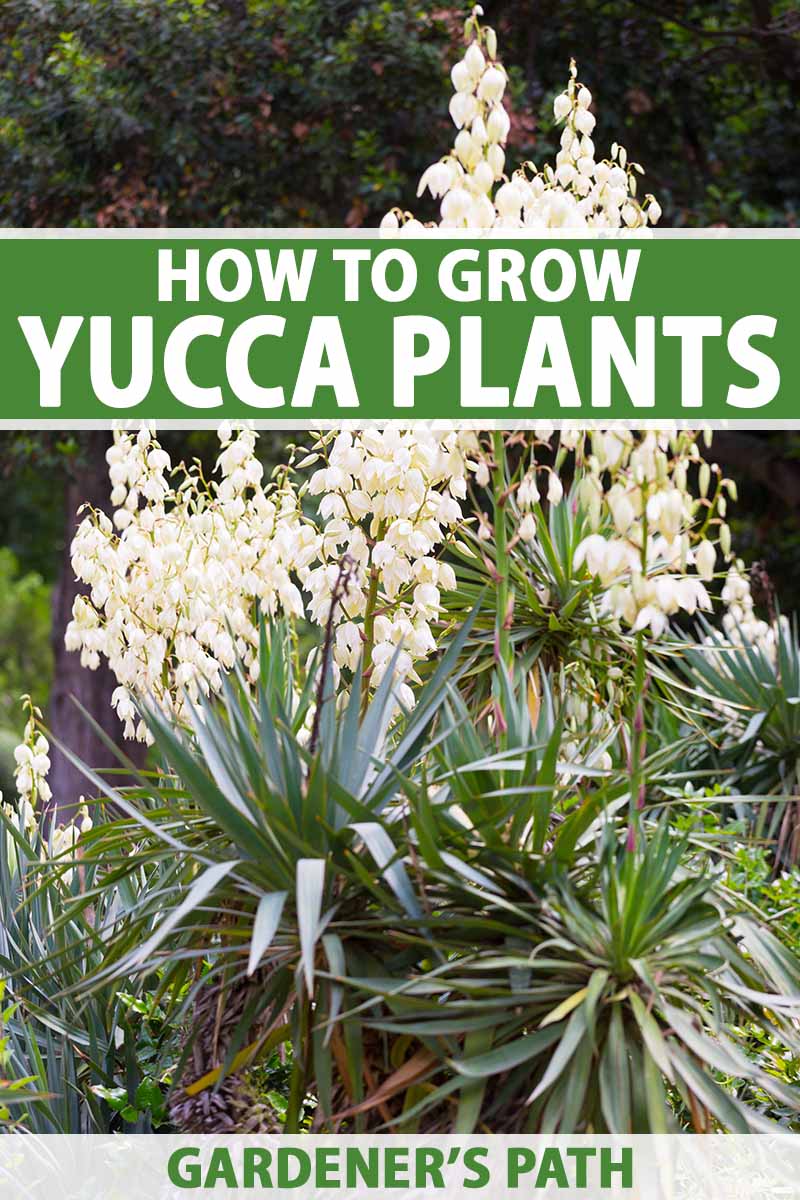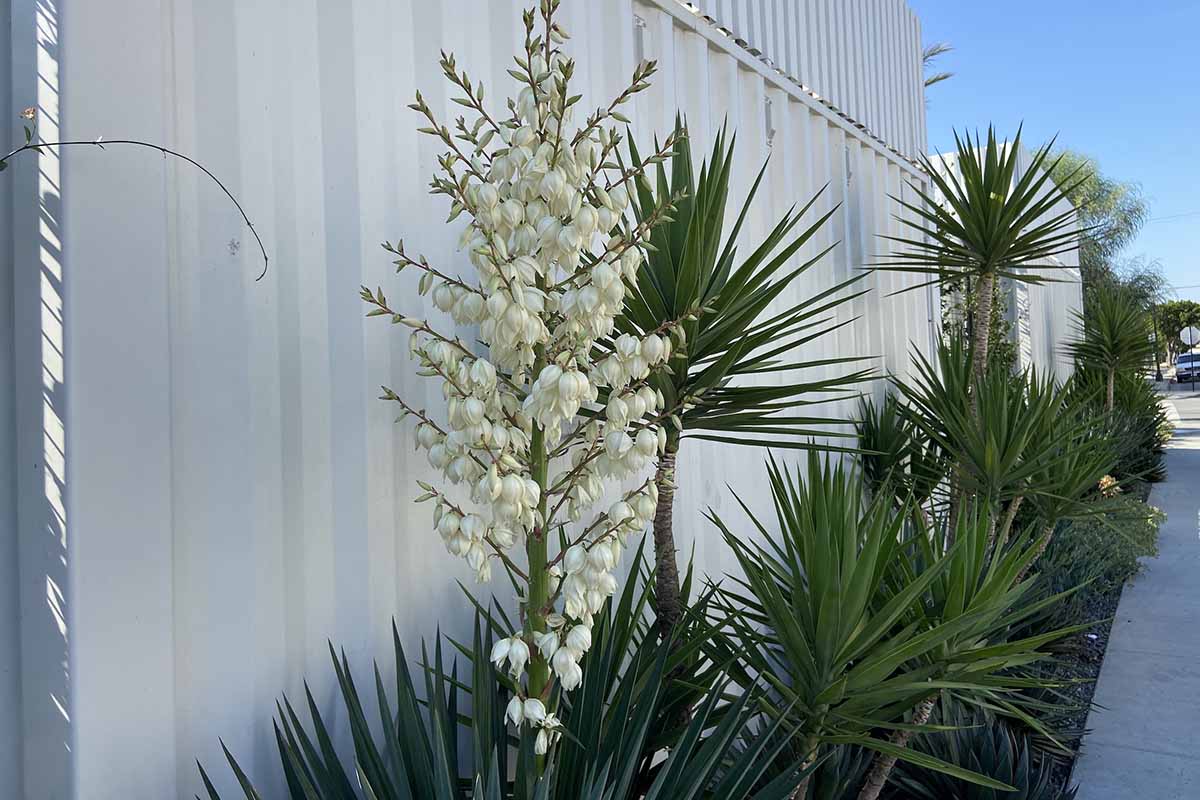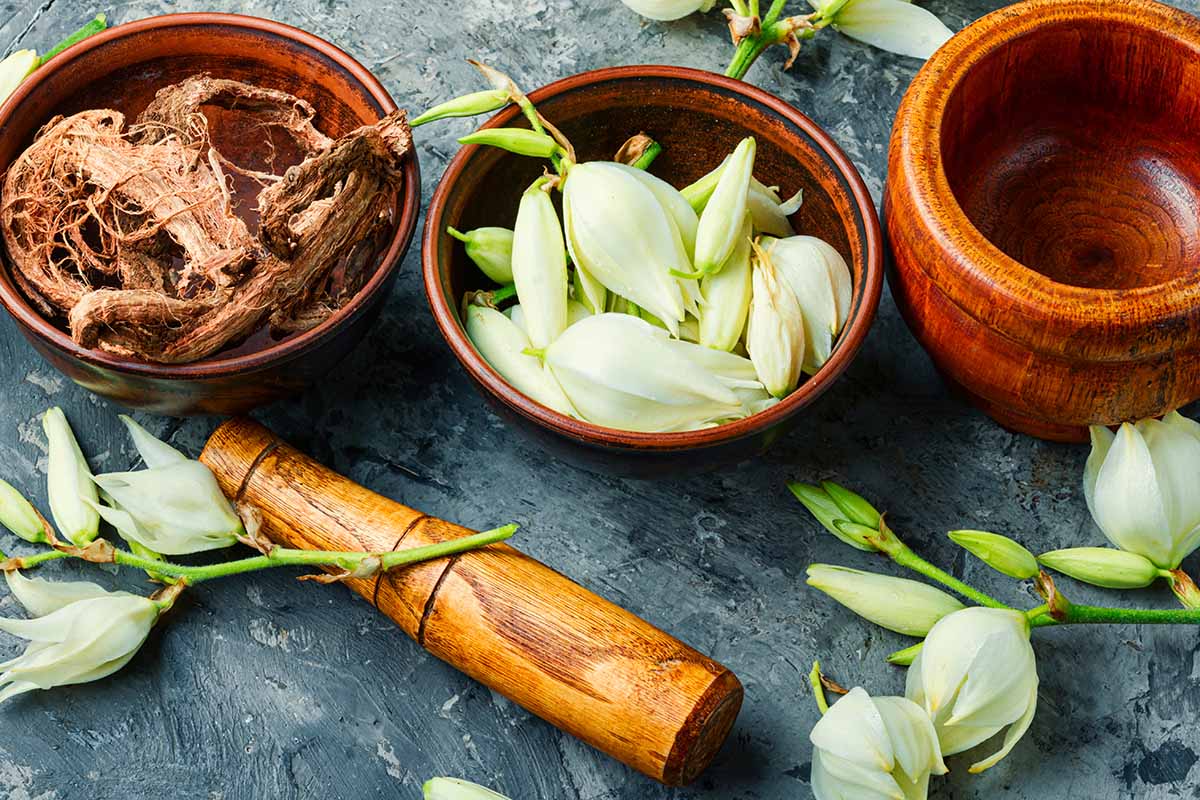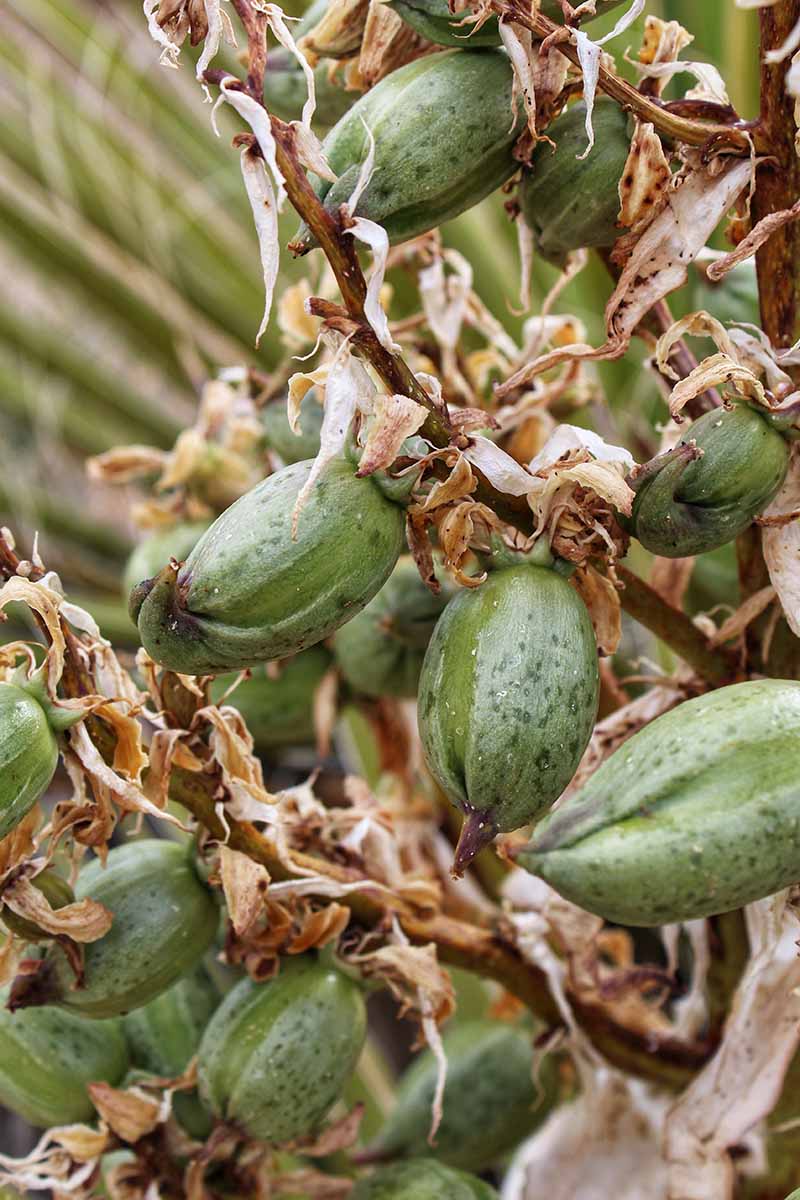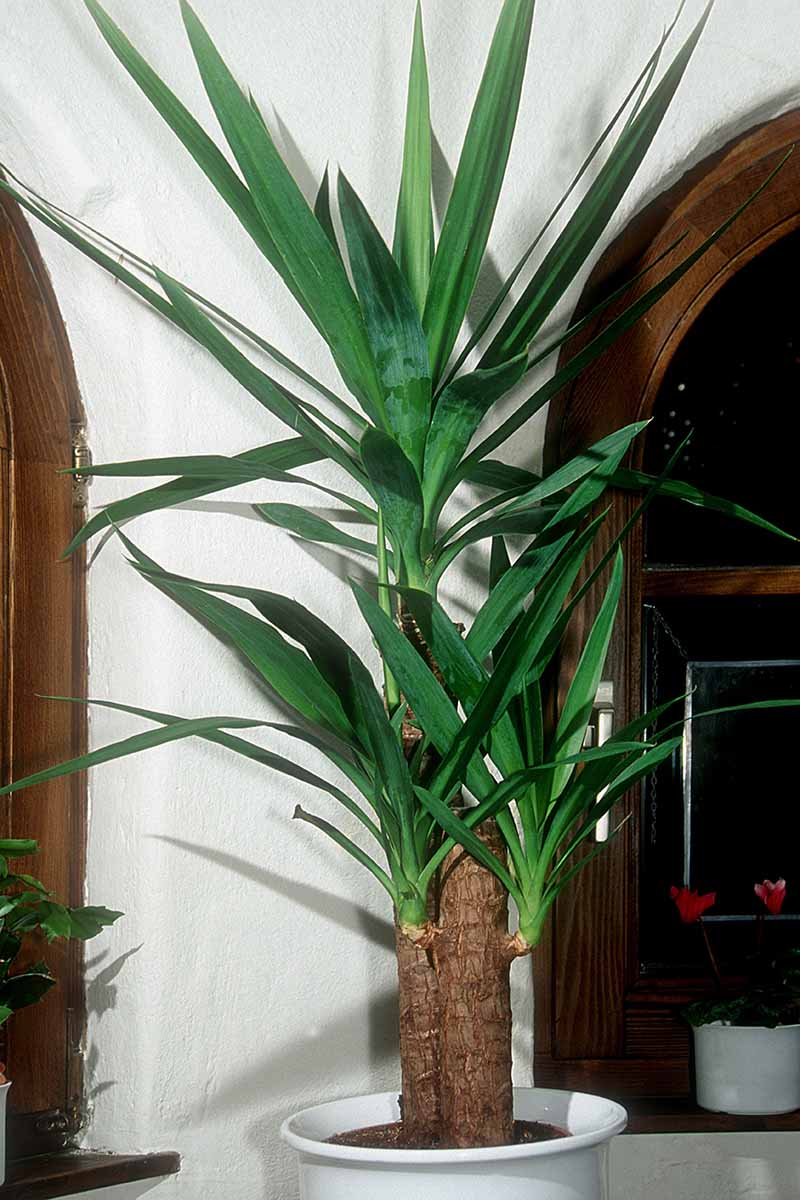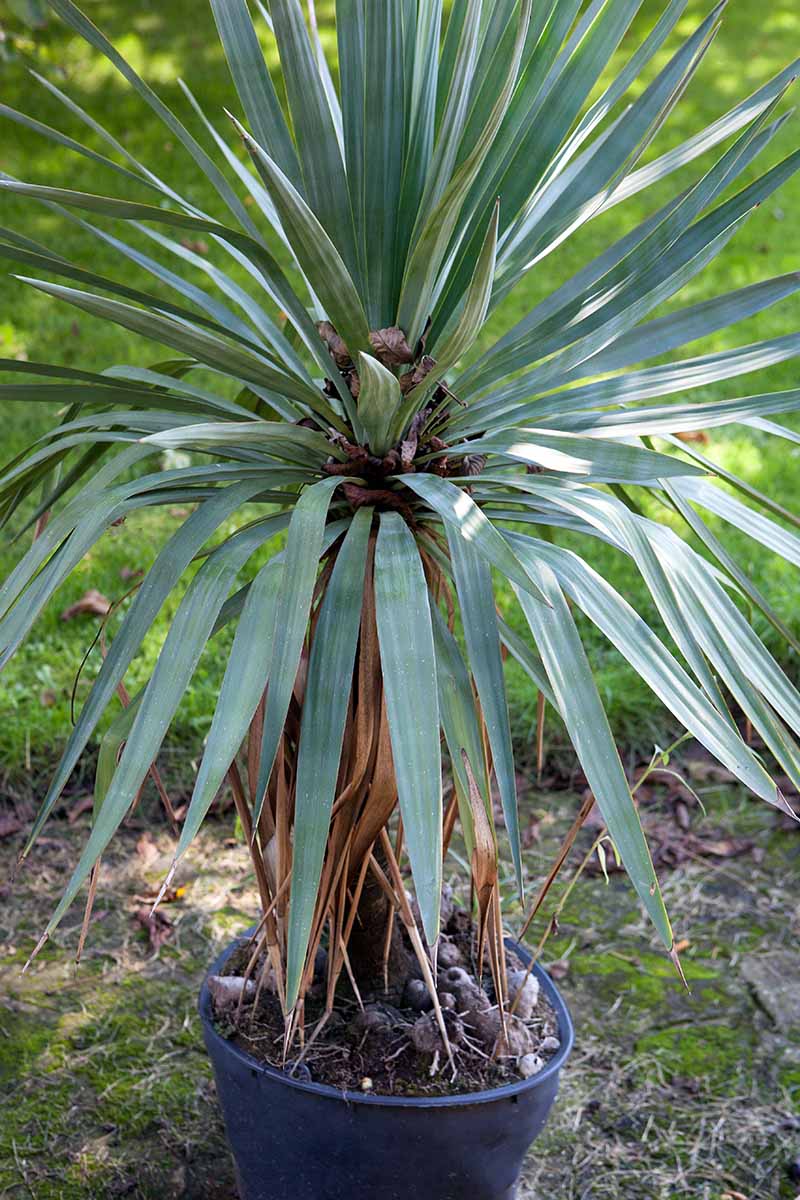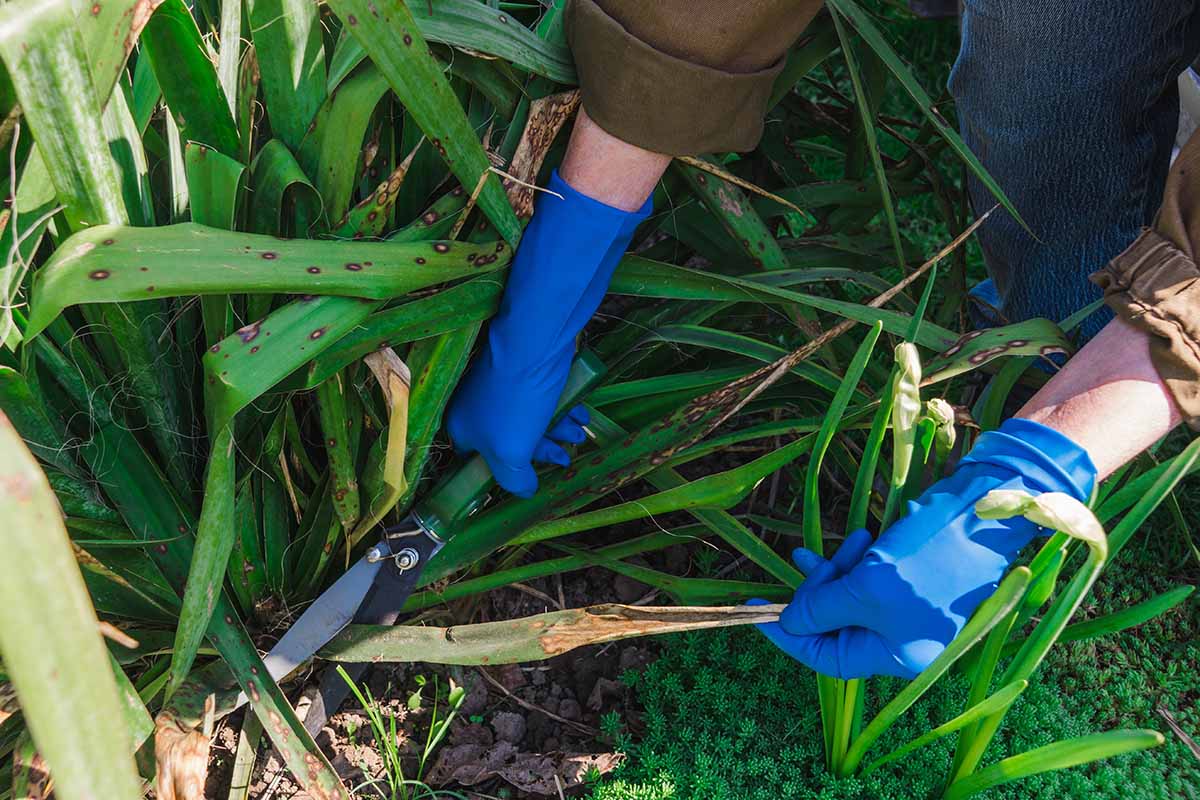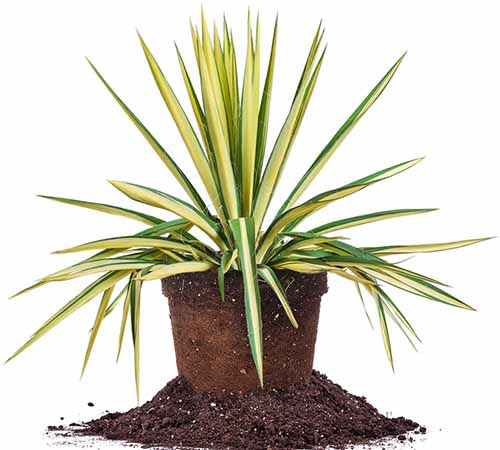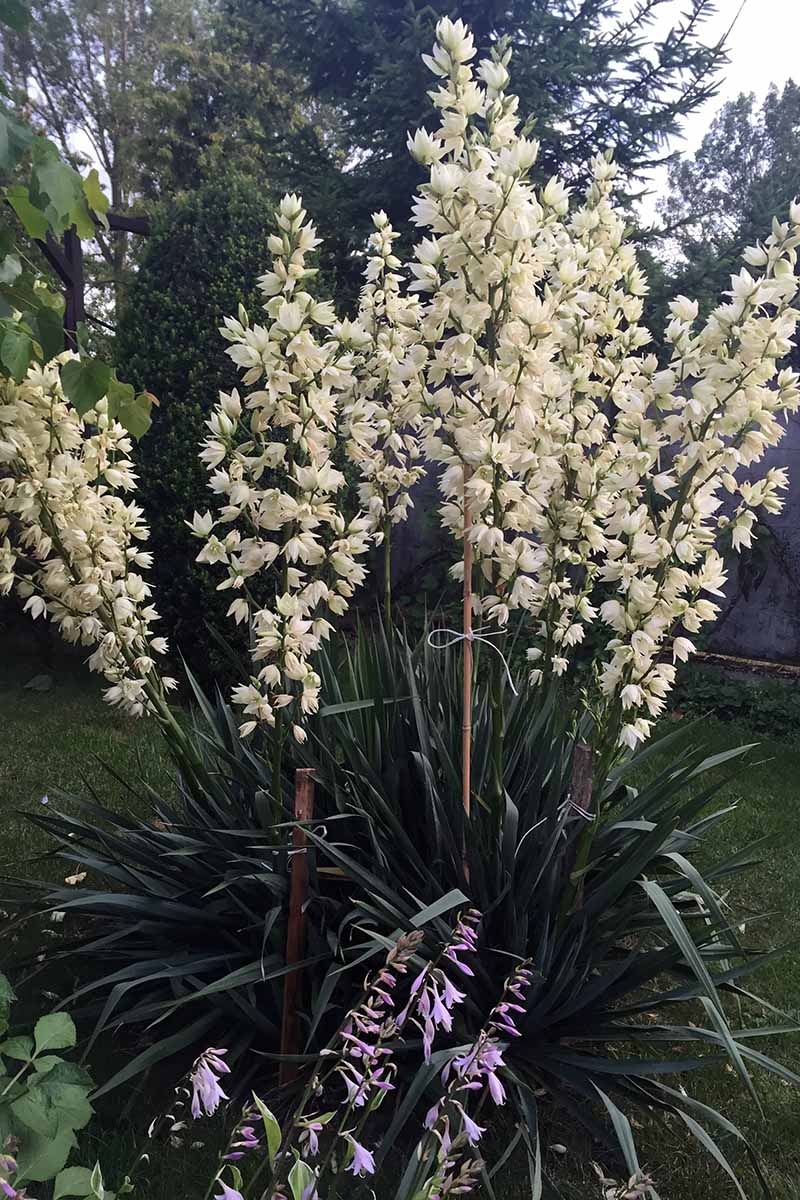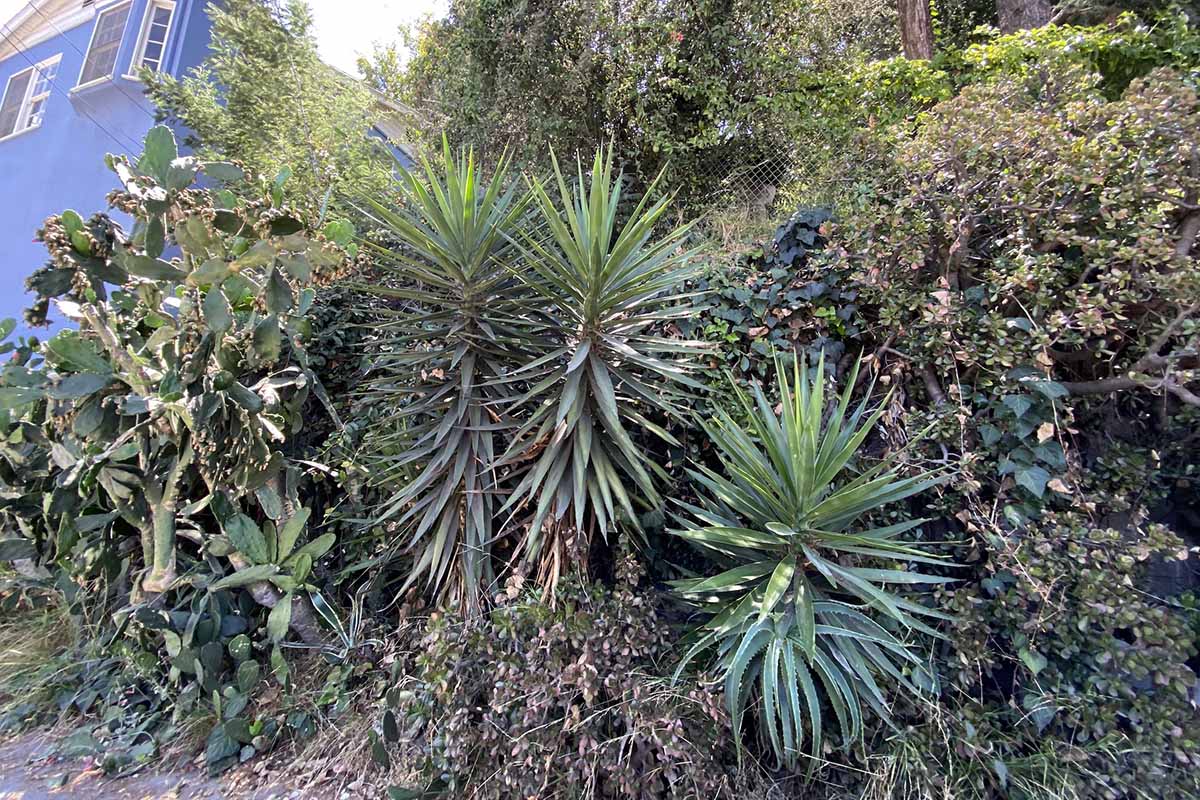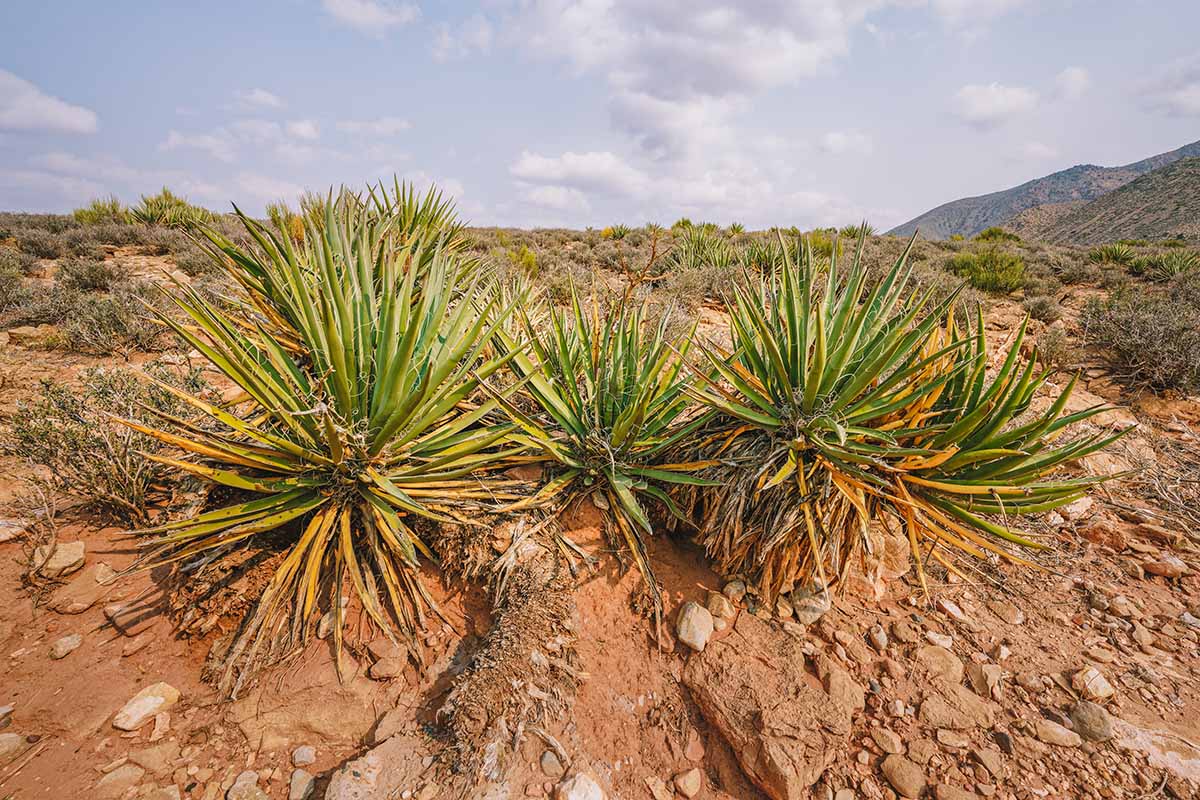We link to vendors to help you find relevant products. If you buy from one of our links, we may earn a commission. These slow-growing succulent perennials are easy to care for, and various versatile and impressive species are available to home gardeners. They range in size from shrubs to trees and many types can be grown in containers. Continue reading to learn everything you need to know about growing yucca, including several recommended selections to grow at home. Here’s what’s ahead:
Cultivation and History
There are 51 accepted Yucca species that belong to the Asparagaceae family. These are members of the subfamily Agavoideae, the same family as Agave. Native to North America, Central America, and Bermuda, this resilient perennial has an extensive range. Most are suited for cultivation in USDA Hardiness Zones 5 to 11, while a few can survive colder winters beyond that range. All species generally flourish in warm climates and well-drained soil. Some yuccas resemble trees, while others look more like shrubs. Their sharp and spine-tipped leaves grow in rosette form at ground level or on stalks which are sometimes called canes. Their foliage color ranges from green to bluish green, with a few cultivars having variegated leaves that are yellow and green. All yucca flowers are bell-shaped and bloom during spring and summer, emerging from buds that form on top of long flower stalks. The flowers are usually cream-colored to white, and some have tinges of purple. The height of the flower stalk depends on the species – these can sometimes reach over nine feet tall. Grown outdoors, yuccas can live for generations. Their height ranges from two to over 30 feet tall, depending on the species. They are valued as architectural plants in the landscape industry, used to add dramatic accents. Thanks to this practice, we can observe them growing in the wild as well as in various city spaces. Several related lookalikes and certain species that have recently been reclassified into their own genus are commonly referred to as “yuccas.” When at a plant nursery, look for the botanical name, not just the common name, to correctly identify them. In the wild, another plant they can sometimes be mistaken for is agave. The easiest way to tell them apart is by the width of their leaves. Agave has broader leaves, sometimes with spikes along the edges, while yucca has narrower leaves without spikes. For additional clarity, yucca is not the same as yuca. Yuca spelled with one “c” is commonly called cassava in English, and is known for its edible root that is sometimes processed and used to make gluten-free flour. The relationship between some species of Tegeticula or Parategeticula moths with particular species of yucca is a classic example of coevolution. In fact, their bond gave these insects their common name, yucca moths. Through what ecologists call obligate mutualism, these moths have a longstanding relationship with the plants, and act as their only pollinators. The moths pollinate the flowers while laying their eggs, and the larvae feed exclusively on yucca seeds. Over time, this led the yuccas to lose their nectar, and yuccas cultivated in regions where these specialized moths do not exist today have to be hand-pollinated in order to produce seed. Yuccas are utilized by members of Indigenous cultures in various ways. The flowers, green pods, seeds, and roots are enjoyed as food, and the leaves are used as a topical first aid remedy, and can be pounded down into usable fiber. In addition, the root is used to make a soapy substance used in ceremonies. Preserving native species of yucca is not only essential to the perennial’s surrounding ecosystem but also to conserving Indigenous foodways and culture. Currently, several yucca species are protected by the states where they grow wild, primarily because of the threats of habitat destruction and, for some, because of their limited growing range. Y. capensis, an endemic native species from Baja California, is considered endangered for these reasons. Y. queretaroensis, another species endemic to Mexico, is also regarded as endangered. This rare plant is restricted from international trade as it is listed under the Convention on International Trade in Endangered Species of Wild Fauna and Flora Appendix II, which documents species that may become extinct unless trade is strictly regulated. There are several other yuccas that have their own tale to tell, which makes them such an intriguing species to learn about and cultivate.
Propagation
The quickest and most beneficial way to produce more yucca plants is by rooting cuttings. Results may vary when propagating from seed. Ensuring that you have viable seeds available before planting will help increase germination rates.
From Seed
Spring is the best time to sow seeds outdoors. Hardy varieties can be sown in early spring, and more tender varieties should be started later in the season when outdoor temperatures have reached 65°F. Remove any seeds with holes and discard them. Soak the rest in water overnight before planting. If any seeds float to the top, remove them as they are not likely to sprout. Plants produced from seeds sown outdoors are more resilient to weather fluctuations, since they have been exposed to local conditions. Seeds can also be started indoors. Sow seeds just below the surface of the soil spaced two to five feet apart, depending on the species. Keep the growing area lightly moist until you observe signs of germination, which should take about three to four weeks. Water seedlings once a week, or more often in the absence of rain, to help them become established. When sowing seeds indoors, temperatures must be between 65 and 75°F. Fill four-inch pots with a moist seed-starting mix suitable for succulents or cacti. Sow seeds just below the soil’s surface and place them near a bright window or under grow lights. Keep the soil slightly moist but not oversaturated, as this can lead to rot. Seedlings started indoors can benefit from staying in a suitable container for about two years, since they can be susceptible to damage in extreme weather conditions.
From Cuttings
Yucca can be propagated relatively easily from cuttings, and stem cuttings can be taken from spring into summer. Take a cutting at least six inches in length or up to one foot. Remove the bottommost leaves while leaving a few intact at the tip, and let the cut end dry and callus over. This should take about two days. Bury it halfway in a half-gallon container filled with cactus or succulent potting mix with the cut end facing downwards. Place the container where it can receive indirect sunlight. Roots should develop in three to four weeks. Water thoroughly and then ensure the growing medium stays slightly moist without becoming overly saturated, which can rot the cutting. Roots will develop in about four weeks. While your rooted yucca cutting matures, place it in a warm location with bright light and provide water weekly. Allow the top inch of soil to dry out between waterings. In approximately 12 months, your new yucca plant will be ready for transplanting as described below.
From Divisions
Because yucca will produce offsets, you can easily divide and propagate them in spring. But if you live in an area that experiences mild winters and intense summer heat waves, it’s best to divide them in fall. That will give them the winter and spring to establish a robust root system. It’s a good idea to divide yucca plants when the offsets are still small. As they grow larger, more strength will be required to separate them. Use a sharp shovel to carefully dig down between the mother plant and the offset, cutting through the root that connects the pup to the plant. Dig up the offset along with its root system. Be careful and wear gloves and long sleeves. Using protective gear when moving yucca plants can save you from being punctured by their spiny-tipped leaves. Transplant the baby yuccas as described below in an area where they will receive full sun. You can also divide your taller plants in two if you wish by topping or cutting the stem in half, and transplanting the division into an appropriately-sized container to take root. The bottom part of the plant will sprout new growth from the cut. Place the cut section into a container filled with a potting mix for succulents or cacti, and water in well. As the division may be top-heavy, you’ll need to place a stake into the pot to help it to remain upright while it roots. Place in a sheltered spot away from wind that may knock it over. Roots should form in about a month, and the division can be transplanted as discussed below.
Transplanting
If you live in a temperate area, seedlings may be transplanted to their permanent location outdoors eight to 10 weeks after germination. Keep in mind that because yuccas can spread via rhizomes and have strong trunks, it’s best to plant them away from building foundations. The height of some species can also pose a threat to roof structures. It’s best to transplant potted plants and cuttings in the fall to allow roots to develop before the brighter seasons encourage leaf growth. Dig a hole the size of the root ball, place the plant there, then fill and cover with the soil you removed from the hole. Gently pat around the base of the plant and water deeply. Continue to water sparingly every two weeks until the plant is established, which can sometimes take up to a year. If you started your seeds indoors, keep your seedlings inside until they have grown for at least two years, ensuring they are strong enough to adapt to outdoor conditions. Once night-time temperatures stay consistently above 45°F, typically in spring, you can transplant them into the ground or plant them in a larger pot if you plan to keep them in an outdoor container. When planting your seedling into a container make sure you choose one with drainage holes that’s large enough for the root system to grow but not too big. Larger pots that can hold more soil will also retain excessive moisture, which this succulent does not need. Use a succulent and cacti soil mix that includes some sand or pebbles to support good drainage. Place the plant in full sun and water only when the top two inches of soil are dry, approximately once every two weeks.
How to Grow
Unless noted for your selected species, yuccas generally grow best in well-drained soil and full sun. According to experts at the University of Florida Cooperative Extension Service, maintaining a soil pH of 5.5 to 6.5 is best, while a pH above 6.5 can cause iron deficiencies. When planting in native soil, be sure to test it first. Most succulents require little to no supplemental water once established, and these species are no exception. Overwatering is a common practice that should be avoided, as it can quickly weaken their roots and lead to rot. Potted plants can benefit from minimal monthly fertilization during the warmer seasons. They can grow happily for years in containers and should only be repotted when necessary. Because some species have sharp points at the end of their leaves that can poke passersby, planting them away from pathways is helpful, or you can trim off the pesky points if you wish.
Growing Tips
Maintain a soil pH of 5.5 to 6.5.Grow in well-drained soil and do not overwater.In-ground plants thrive in full sun.
Pruning and Maintenance
The general upkeep of this succulent is minimal. You don’t have to prune yuccas, but it will help to keep their appearance tidy. It also helps to know how to approach pruning with these plants so you can manage their growth whether they’re planted in the ground or potted. Once a year, at any time during the growing season, remove any dead leaves and trim off leaves that begin to point downwards if you prefer them not to have a “skirt” look. After flowers have finished blooming and produced seeds you can cut the flower stalks down to help maintain the current height of the plant. Some of these can grow extremely tall. If the flower stalk’s height poses a risk to existing structures like your roof, you can trim them down sooner. Leaves and flower stalks may be composted. If there are many offsets growing around your main plant you can divide and propagate them as described above, to avoid overcrowding. This is especially important if you want to maintain the current width of your yucca. If you notice roots reaching through the surface of a potted plant, it’s time to repot. To help yuccas overwinter in areas that experience frost, cut the stalks down to the ground in late fall. Then add a thick layer of mulch, about six inches, over the plant before the first frost. Your mulch can be made up of raked leaves and shredded bark. Next, place a plastic or burlap covering over the mulch to add extra protection. Secure the edges with stakes or heavy rocks. Remove after the last frost of the season. An ideal selection for those in Southern California that enjoy growing native plants and want to fill a large space, Mojave yucca grows in USDA Hardiness Zones 9 to 10.
Color Guard
Y. filamentosa is native to the southeastern United States. These plants grow in Zones 4 to 10 and enjoy full sun or partial shade. Their mature width and height can reach four feet in either direction. Y. filamentosa ‘Color Guard’ is tolerant of diverse climates, making this a highly sought-after selection. Ideal for xeriscaping, this cultivar adds a striking display of variegated foliage with yellow-white center streaks. ‘Color Guard’ This variety is available from My Perfect Plants.
Mojave
Native to southern California, Y. schidigera, also known as izote de Ensenada in Spanish, can be found growing in mountain chaparral, coastal sage scrub, and in some areas of the desert. This slow-grower can reach over 10 feet tall as it ages, and older plants usually produce multiple branches with leaf rosettes.
Soapweed
Native to North America, Y. glauca, also known as beargrass, can be found growing in dry plains and sandhills. Its long-lasting evergreen leaves are about two feet long and narrow, growing in wide clumps about three to four feet wide. The eye-catching flower stalks can reach up to five feet in height. Soapweed yucca grows in USDA Hardiness Zones 3 to 10. It can withstand various light conditions but does not thrive in coastal environments.
Managing Pests and Disease
These tough succulents are susceptible to very few pests and diseases. The ones mentioned below are not common issues, but when they are present they should be managed quickly, so they don’t spread and cause problems in the surrounding ecosystem.
Insects
Once you are aware of the potential presence of the few insects that are viewed as pests of these plants, you should be able to manage them. Growing biodiverse plant species suited to your growing area will encourage a balanced ecosystem that can practically manage itself.
Mealybugs
These insects in the family Pseudococcidae feed on plant juices and appear as white cotton-like masses that can be found on the undersides of leaves. They excrete honeydew that attracts ants. In addition, the honeydew creates ideal conditions for sooty mold, an unsightly fungal growth. Thankfully they can easily be sprayed off with a hose, just like aphids. Read more about dealing with a mealybug infestation in our guide.
Scale
Scale insects belong to the superfamily Coccoidea. These armored insects are not as easy to control as mealybugs, their cousins, but can be managed with applications of neem oil. They appear as spots on plants, and as they mature, they resemble small oval bumps with a protective covering that looks like a shell. When there are a lot of them, they can harm plant growth. Scale on yucca tend to target the leaves. Learn more about identifying and controlling scale in our guide.
Weevils
The yucca weevil, Scyphophorus yuccae, is primarily an issue in southern California but can occur throughout the state. Experts at the University of California Statewide Integrated Pest Management Program affirm that preventive measures are the only effective control for this weevil. Be sure to provide plants with the optimal recommended growing conditions and care. The adult weevil is black, can grow up to three-quarters of an inch in length, and has long, narrow mouthparts and a small elongated head. It has grooves on its wing covers and a smooth, finely punctured thorax. The adults do not cause harmful damage to plants, but the larvae can. Adult feeding creates holes in the leaves and discoloration. The larvae are about an inch long and feed on roots and stems. Large infestations can cause the plant to die. If an infestation occurs, removing the entire plant and disposing of it as green waste is best.
Disease
There are a few fungal diseases that can affect yuccas. The main way to prevent them is by avoiding overwatering and never watering the plants from above. Focusing on watering at the soil line without splashing on the leaves is key!
Cercospora Leaf Spot
The leaf spots caused by Cercospora fungi are about a quarter of an inch in width and turn from rust-colored to brown. Avoid watering foliage and remove all affected leaves to keep spores from spreading. Instead of placing the leaves in your green waste, you could burn the infected plant matter to ensure the spores die.
Best Uses
These plants are the optimal choice for xeriscaping and native plant gardens. Including them in landscapes with other drought-tolerant species will help save water. Prevent brown spot by only watering as needed at the soil line, and remove any infected plants as soon as you see them. Arber Biofungicide Fungal and bacterial plant diseases like this can all be controlled with this biofungicide by Arber that is available in 16-ounce bottles from Terrain.
Gray Leaf Spot
In the early stages, this disease will display graying and browning of leaf tips and edges. Then the foliage will develop lesions about three inches in diameter and die. Gray leaf spot is caused by fungi in the Cytospora genus. As with the other diseases described so far, this one is also spread via moist conditions that are created by overhead watering or water splashing onto leaves.
Southern Blight
The effects of this disease are most apparent on the stem of the plant. Soilborne Sclerotium rolfsii fungi causes this disease. If your plants are infected, you will first notice white fungal threads forming a fan shape, and circular lesions form as it progresses. As with the other plant diseases mentioned here, eliminate the infected plant matter to keep spores from spreading. Arber Bioprotectant You could apply a bio-protectant like this one by Arber that’s available in 16-ounce bottles from Terrain. This product uses an extract of the giant knotweed plant (Reynoutria sachalinensis), which helps to provide protection without using synthetic chemicals. When applied to the plant, it will begin to produce extra proteins and compounds that act as fungal and bacterial growth inhibitors. Their blooms offer a subtle aroma that is enjoyable while also attracting various pollinators, making them fitting for pollinator gardens. Certain varieties are excellent to grow indoors as nearly foolproof houseplants. Because of their height, planting them together in rows creates a strong security hedge, further enhanced by the spike-tipped leaves. Be sure to plant with caution in yards where young children and curious pets like to play.
Quick Reference Growing Guide
They are so versatile and look appealing in outdoor containers too. The many varieties that are available provide you with several options that give gardens more structure and added curb appeal while saving water. Do you have a xeriscape garden with yucca growing as a key feature? Have you seen those amazing blooms? Tell us all about it by commenting below, and feel free to share your photos. Did this guide spark your interest in inviting more drought-tolerant plants like succulents and cacti home? Check out these articles next, which highlight a few more of our favorites:
How to Grow and Care for Agave in the GardenHow to Grow Prickly Pear CactusHow to Grow and Care for Aloe Vera
